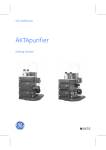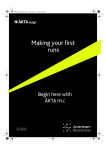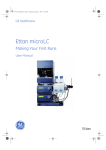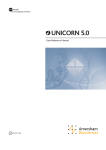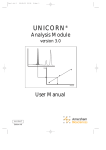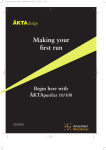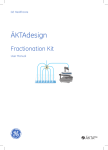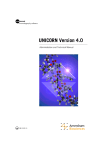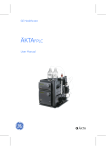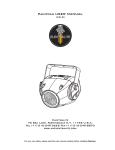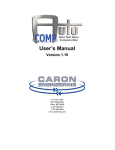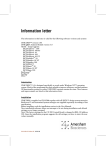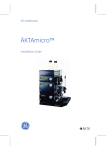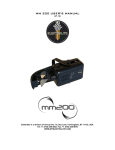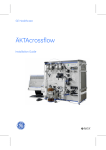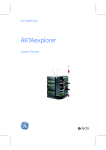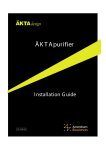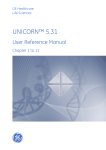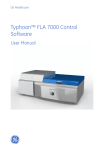Download ÄKTAexplorer, making your first runs
Transcript
GE Healthcare ÄKTAexplorer Making your first runs Contents 1 About this guide ........................................................................7 1.1 1.2 2 The system and the software..................................................9 2.1 2.2 2.3 2.4 2.5 3 4 Pre-requisites .................................................................................. 7 Typographical conventions .......................................................... 8 General ............................................................................................. 9 ÄKTAexplorer 100 ......................................................................... 13 ÄKTAexplorer 10 ........................................................................... 13 UNICORN overview ...................................................................... 14 Help ................................................................................................. 17 Creating a method ................................................................. 19 Preparing the system for a run............................................ 23 4.1 4.2 System connection ....................................................................... 23 General system preparation ...................................................... 24 4.2.1 Filling the inlet tubing.............................................................................. 25 4.2.2 Filling the sample loop ........................................................................... 26 5 Starting a run .......................................................................... 27 6 Viewing a run .......................................................................... 33 7 Viewing and printing the result ........................................... 37 7.1 7.2 Viewing ........................................................................................... 37 Printing and making a report .................................................... 40 8 Buffer prep............................................................................... 43 9 Scouting ................................................................................... 45 10 Going further........................................................................... 47 Index................................................................................................ 49 ÄKTAexplorer Making Your First Runs 18-1140-78 Edition AF 3 4 ÄKTAexplorer Making Your First Runs 18-1140-78 Edition AF Important user information All users must read this entire manual to fully understand the safe use of ÄKTAdesign. WARNING! All repairs should be done by personnel authorized by GE Healthcare. Do not open any covers or replace parts unless specifically stated in the instructions. Important! ÄKTAdesign is intended for research use only, and should not be used in any clinical or in vitro procedures for diagnostic purposes. ÄKTAdesign should not be used in any clinical or in vitro procedures for diagnostic purposes. Safety notices This manual contains warnings and cautions concerning the safe use of the product. See definitions below. WARNING! The WARNING symbol and notice highlight instructions that must be followed to avoid personal injury. Do not proceed until all stated conditions are clearly understood and met. CAUTION! The CAUTION notice highlights instructions that must be followed to avoid damage to the product or other equipment. Do not proceed until all stated conditions are met and clearly understood. Notes Note: A Note is used to indicate information that is important for trouble-free and optimal use of the product. Recycling This symbol indicates that the waste of electrical and electronic equipment must not be disposed as unsorted municipal waste and must be collected separately. Please contact an authorized representative of the manufacturer for information concerning the decommissioning of equipment. WARNING! This is a Class A product. In a domestic environment, it might cause radio interference, in which case the user might be required to take appropriate measures. CE-certification This product complies with the European directives listed below, by fulfilling corresponding standards. A copy of the Declaration of Conformity is available on request. • 73/23/EEC, Low Voltage Directive • 89/336/EEC, EMC Directive The CE logo and corresponding declaration of conformity, is valid for the instrument when it is: – used as a stand-alone unit, or – connected to other CE-marked GE Healthcare instruments, or – connected to other products recommended or described in this manual, and – used in the same state as it was delivered from GE Healthcare except for alterations described in this manual. Note: The Declaration of conformity is valid only for systems that are marked with the CE logo: About this guide 1 1 About this guide This guide is written for users who are not familiar with UNICORN™ software and ÄKTA™explorer. Here you will learn the basics of UNICORN and how to operate ÄKTAexplorer™ from UNICORN. UNICORN is a software package for control and supervision of the ÄKTAexplorer chromatography system. It runs on an IBM-compatible PC under Windows™, and includes hardware for interfacing the controlling PC to the chromatography liquid handling parts of ÄKTAexplorer. In this guide you will learn how to: • create methods • prepare the system for runs • perform runs • make simple evaluations • make reports • perform automatic method optimization (Scouting) • prepare automatically buffers of any pH (BufferPrep) Follow the guide from page to page in front of the computer. The time will be well spent. Note: To follow the instructions it is not necessary to read the comments (written with smaller font) containing additional information. 1.1 Pre-requisites Before using the system, see the separate Installation guide: • the system and the software must be installed and functioning, and • the monitor and the pump must be calibrated as described in the guide. IMPORTANT! Before using ÄKTAexplorer, read all the safety information in ÄKTAexplorer System Manual. ÄKTAexplorer Making Your First Runs 18-1140-78 Edition AF 7 1 About this guide 1.2 Typographical conventions 1.2 Typographical conventions Menu commands and dialog box prompts are identified in the text by bold text. A colon separates menu levels, thus File:Open refers to the Open command in the File menu. 8 ÄKTAexplorer Making Your First Runs 18-1140-78 Edition AF The system and the software 2 2 2.1 The system and the software General ÄKTAexplorer is a fully automated liquid chromatography system designed for method development and research applications. The separation unit of the chromatography system has three main modules which are stacked on the lefthand side of a base platform. They are: • Pump P-900, a family of binary high performance gradient pumps. In ÄKTAexplorer 100 the flow rate is up to 100 ml/min and the pressure up to 10 MPa (pump designation is P-901). In ÄKTAexplorer 10 the flow rate is up to 10 ml/min and pressure up to 25 MPa (pump designation is P-903). • Monitor UV-900, a multi-wavelength UV-Vis monitor for simultaneous monitoring of up to 3 wavelengths in the range 190–700 nm. • Monitor pH/C-900, a combined monitor for on-line conductivity and pH monitoring. If installing a fraction collector, it should be placed on the right-hand side of the system: ÄKTAexplorer Making Your First Runs 18-1140-78 Edition AF 9 2 The system and the software 2.1 General Components, such as the mixer, column and different valves, are mounted in the section to the right. Open the valve door to view them all. Columns are snapped in place on the outside of the valve door. The separation unit is controlled from UNICORN software. Pump P-900, Monitor UV-900 and Monitor pH/C-900 can also be controlled individually from the modules, without UNICORN software. In this guide, however, you will only learn how to operate the chromatography system from UNICORN. Switch on the chromatography system with the ON/OFF button located on the front of the base platform to the bottom left. 10 ÄKTAexplorer Making Your First Runs 18-1140-78 Edition AF The system and the software 2 Outlet Valve, V4 (PV-908) Flow Direction Valve, V7 (INV-907), (standard component only in ÄKTAexplorer 100 and ÄKTAexplorer 100 Air Buffer Valve, V6 (IV-908) Column Selection Valve, V2 (PV-908) Injection Valve, V1 (INV-907) Box-900 Monitor pH/C-900 Monitor P- 910 Monitor UV-900 Monitor P- 910 Sample Valve, V5* (PV-908) 0, 6 Pump P-900 (P-901 alt. P-903) M-92 5 Column Selection Valve, V3 (PV-908) Mon itor P- 910 Valve door Mixer M-925 Sample Pump P-960* Mains switch Switch Valve (SV-903) UV cell *) standard component only in ÄKTAexplorer 100, ÄKTAexplorer 100 Air ÄKTAexplorer 10 S Conductivity cell Column Selection Valve, V2 (PV-908) Injection valve, V1 (INV-907) Column Column Holders Outlet Valve, V4 (PV-908) Sample Valve, V5* (PV-908) pH electrode Flow restrictor To Fraction Collector Column Selection Valve, V3 (PV-908) Sample Tubing Holder* Sample Tube Holder* Sample Tray* ÄKTAexplorer Making Your First Runs 18-1140-78 Edition AF *) Only in ÄKTAexplorer 100 and ÄKTAexplorer 10S 11 2 The system and the software 2.1 General Comment: The flow path between the different modules and components in the separation unit is shown and described below. It is not necessary to go through this in detail to make your first runs. Open the valve door if you want to follow the description. 1 Buffer A is connected to inlet A11 of the buffer valve which is placed at the back of the system. Up to 8 different buffers can be connected to the buffer valve. Buffer B is connected to inlet B1. Inlet A2 and B2 are used when buffers are prepared automatically by BufferPrep. 2 Buffer passes the two switch valves placed between the pump heads as it is drawn to the pump. The pump has 4 pump heads, two for pump A and two for pump B. Pump A is the one closest to the front. 3 The flow path continues from the pump to the mixer, then to the on-line filter and forward to the injection valve. 4 A sample loop can be connected between ports 2 and 6 on the injection valve. 5 12 • In ÄKTAexplorer 100 and in ÄKTAexplorer 10S, the sample loop can be filled manually or automatically using the sample pump. Connect the inlet tubing on the sample pump to port 3 on the injection valve. The sample pump draws sample from one of the inlets on the sample valve to fill the sample loop. • In ÄKTAexplorer 10, the sample loop can be filled manually using syringe; connect a fill port to port 3 on the injection valve. After the injection valve, the flow is forwarded to the column: • In ÄKTAexplorer 100, the flow first passes a flow direction valve inside the door. The flow direction valve allows the flow direction through the column to be selected. The flow then continues to the first column valve.After the column, the flow passes the flow direction valve again and then forward to the UV cell and the conductivity cell which are placed inside the cell holder on Monitor UV-900. • In ÄKTAexplorer 10, the flow passes the first column valve. The column is connected between the two column valves. Up to 7 columns can be connected. A bypass tubing is connected to position 1 on the two column valves. After the second column valve the flow is forwarded to the UV cell and the conductivity cell which are placed inside the cell holder on monitor UV-900. 6 The flow path continues to the pH flow cell on the outside of the door, to the flow restrictor and then to the outlet valve, which is used to select fraction collection method, and to handle waste and flowthrough. 7 The flow path can continue to the fraction collector (optional) if desired. ÄKTAexplorer Making Your First Runs 18-1140-78 Edition AF The system and the software 2 2.2 ÄKTAexplorer 100 System pump Buffer Sample Mixer On-line filter Injection valve Column Flow direction valve Monitoring Fractionation UV-monitor Conductivity monitor pH-monitor Outlet valve Flow restrictor Sample pump Column selection valve Sample valve Switch valves Waste Buffer valve Column selection valve To fraction collector (optional) Waste 2.3 ÄKTAexplorer 10 System pump Buffer Sample Mixer Column On-line filter Monitoring Fractionation UV-monitor Conductivity monitor pH-monitor Injection valve Outlet valve Flow restrictor Column selection valve Switch valves Waste Buffer valve Waste A2 B1 B2 To fraction collector (optional) A1 1 ÄKTAexplorer Making Your First Runs 18-1140-78 Edition AF Column selection valve 13 2 The system and the software 2.4 UNICORN overview 2.4 UNICORN overview 1 Switch on the computer. Log on to Windows by first pressing Ctrl-Alt-Del and then clicking OK. After a while the Windows desktop appears. 2 Start UNICORN by double-clicking on the UNICORN icon. 3 An information window appears during start-up. 4 In the Logon dialog, select a user from the Users list and enter the password. If you log on for the very first time, select user default and enter the password default. Click OK. Note: You should enter users and individual passwords before starting using ÄKTAexplorer on a regular basis. 14 ÄKTAexplorer Making Your First Runs 18-1140-78 Edition AF The system and the software 2 5 Eventually, the UNICORN Main Menu window appears on the screen. 6 The Main Menu window is the central part of the UNICORN displays. It is mainly used for file handling. From this window you can navigate through the control system. In the Methods pane to the left in Main Menu, all method files that you create are displayed. A method file contains a series of instructions for controlling a run. In the Results pane to the right, all result files are displayed. A result file is the result from a run, including all documentation (e.g. the method used) and the generated chromatogram. ÄKTAexplorer Making Your First Runs 18-1140-78 Edition AF 15 2 The system and the software 2.4 UNICORN overview In general, UNICORN consists of 4 different modules of which the Main Menu is one. The other modules are represented by icons in the toolbar. These modules are: Method Editor opens the Method editor with a dialog window for creating new methods. System control opens a dialog window for controlling the system and running your methods. Evaluation opens a dialog window for evaluating your results. To swap between the module windows, click their respective button in the task bar at the bottom of the screen. Additional buttons are provided in the toolbar. These are: Instant run opens a dialog where you directly can choose a method to run. This is handy for starting routine runs instantly. Logon/Logoff opens a dialog to control the logon/logoff process. 1 1 Method Queue opens a dialog window for defining a new Method Queue. Existing Method Queue opens a dialog window for showing the Method Queue that is running. Method Queues are used to link several methods together. 16 ÄKTAexplorer Making Your First Runs 18-1140-78 Edition AF The system and the software 2 2.5 Help Comprehensive on-line help is available. To get help about an instruction or module, place the cursor on the instruction/module and press the F1 key. Alternatively, click on the Help menu in the upper right corner of each module and select Help for...... to get general help about the current instruction or module and find new help topics, or Index for a specific topic. In any dialog, click on the Help button to get help for how to use the current active dialog. ÄKTAexplorer Making Your First Runs 18-1140-78 Edition AF 17 2 The system and the software 2.5 Help 18 ÄKTAexplorer Making Your First Runs 18-1140-78 Edition AF Creating a method 3 3 Creating a method The UNICORN software is supplied with a Method Wizard used for creating new methods. The wizard is a number of dialog windows with questions and instructions that help you creating the method. To create a method: 1 Click the Method Wizard icon in the Method Editor module. If required, choose which system you want to use and click OK.The Method Wizard window appears. Select technique Select column Select column position Select column position To get detailed help texts, click Help Click Next Note: You can restore all settings to default values by clicking Set Default (can only be done in this dialog). 2 Select a chromatographic technique, for example Anion_Exchange. 3 Select the column you intend to use. The correct column volume, the recommended flow rate, and the correct pressure limit for that column will then be automatically implemented in the method. Note: If you manually alter the default values, and thereby exceed the recommended values for the selected column, you will get a warning when you save your method. Note: If you want to perform a test run without a column, you should still select a column (a small one is recommended) to get suitable default parameters in the method. Then, when running the method, use a piece of tubing to replace the column. Note: If you do not find your column in the list, you can add one. Refer to the UNICORN User Manual. ÄKTAexplorer Making Your First Runs 18-1140-78 Edition AF 19 3 Creating a method 4 Select Column Position, and if required, Flexible Flow rates and/or Flow Regulation of the System Pump and/or BufferPrep. 5 Click Next to go through the subsequent windows. In each window, select the appropriate parameter values. 6 Click Finish in the last window. The Run Setup window appears. Click here to select page Run setup consists of a number of pages. You will only look at a few now. Select a page by clicking the respective tab at the top of the window. 20 ÄKTAexplorer Making Your First Runs 18-1140-78 Edition AF Creating a method 3 7 On the Variables page, the method is presented by a number of blocks. The blocks represent typical steps in a chromatographic run, such as: • Start instructions • Column equilibration • Sample injection • Wash out unbound sample • Fractionation • Gradient • Clean after elution • Re-equilibration Some of the blocks contain a number of Variables with suitable default values. The values can be changed to suit your application. Some of the variables are normally hidden but can be shown by checking the Show details box. 8 Click the Gradient tab to view the method graphically. The length of each block is marked at the bottom of the graph. Click the x-axis to view the method in time, volume or column volumes. ÄKTAexplorer Making Your First Runs 18-1140-78 Edition AF 21 3 Creating a method 9 Click the Start Protocol tab to decide which of the Run Setup pages to be displayed at the start of a method run. 10 To save the method, select File:Save. In the Save dialog, enter a name. Store the method in the directory of your choice by doubleclicking on a directory. Click OK. In the UNICORN Main Menu module, the method appears in the Methods window. Note: The method name, followed by three consecutive numbers starting with 001 will then be used as default name for the result file of your method after runs. Now you are ready to start a run. Go to chapters 4 and 5. You can also go to chapter 9 to learn how to alter variables systematically and automatically in repeated runs. This is known as scouting and is a convenient, easy-to-use function. 22 ÄKTAexplorer Making Your First Runs 18-1140-78 Edition AF Preparing the system for a run 4 4 4.1 Preparing the system for a run System connection Before you can start a run, you must connect to the system. Connecting means that the System Control module is set up for a particular system. If you are not connected, the text NO is shown in the Connection panel in the Run Data window. Once you are connected, the text changes to YES. 1 Click on the 1.System Control button in the task bar at the bottom of the screen. 2 To connect to a system: Select System:Connect.... The System connect dialog appears. 3 Select a system symbol. If you are not connected to a network, only one system will be shown. Click OK. When connected, the text YES is shown in the Connection panel in the Run Data pane. You only have to connect once. If you do not select System:Disconnect, you will be automatically connected to the system the next time you log on to UNICORN. ÄKTAexplorer Making Your First Runs 18-1140-78 Edition AF 23 4 Preparing the system for a run 4.2 General system preparation 4.2 General system preparation 1 The correct tubing kit for the column you intend to use must be installed. System Tubing kit, i.d. [mm] ÄKTAexplorer 10 0.25 0.50 ÄKTAexplorer 100 0.50 0.75 1 1 1 1.00 Installed at delivery. See ÄKTAexplorer System Manual for an overview over columns with recommended tubing kits. For most columns the tubing kit mounted at delivery can be used. Note: If tubing with too large inner diameter is used, the peaks will become broader than necessary. If tubing with too small inner diameter is used, the back pressure from the tubing might become higher than the max. pressure for the column and the run will stop immediately after it is started. A11 Buffer Valve V6 24 A2 B1 B2 Alternative placement for tubing holder 2 Immerse inlet tubing A11 (or another inlet tubing if you changed this in the method) in buffer A and inlet tubing B1 (or B2) in buffer B. 3 Check that the waste tubings from port 4 and 5 of the injection valve and port 1 of the outlet valve, are put into a waste bottle. If fraction collector Frac-950 is used, check that the tubing from the chosen port of the outlet valve is connected to the fraction collector. For fraction collector Frac-900, the port 2 of the outlet valve will be selected by default. 4 If there is air in the inlet tubing, or if you suspect air in the pump, purge the pump with a syringe as described in the Pump P-900 User Manual. ÄKTAexplorer Making Your First Runs 18-1140-78 Edition AF Preparing the system for a run 4 5 If pH measurement is required, calibrate the pH monitor. Refer to the UNICORN User Manuals or the Monitor pH/C-900 User Manual. Mount the pH electrode in the flow cell. 6 Connect the column to the two column valves at the position set in the method (normally position 2). When using the bypass tubing, select position 1. 7 Insert a sufficient number of tubes in the fraction collector (optional). 4.2.1 Filling the inlet tubing 1 Select Manual:Pump in the System Control module. The Pump instruction dialog opens. 2 Select the instruction PumpWashExplorer. 3 Select the inlet A11 for Inlet A1. 4 Set Inlet A2 to OFF, Inlet B1 to ON and Inlet B2 to OFF. 5 Click Execute to start filling the tubing. The injection valve will automatically switch to waste during the pump wash. 6 When finished, click End in the System Control toolbar. 7 In the Pump Instructions dialog, click Close to close the dialog. ÄKTAexplorer Making Your First Runs 18-1140-78 Edition AF 25 4 Preparing the system for a run 4.2 General system preparation 4.2.2 1 Filling the sample loop Check that the correct loop is mounted between port 2 and 6 on the injection valve. 3 2 26 Connect an injection fill port or a union luer female/1/16” male to port 3 on the injection valve and apply the sample manually with a syringe. ÄKTAexplorer Making Your First Runs 18-1140-78 Edition AF Starting a run 5 5 Starting a run 1 Open the System Control module. 2 Select File:Run... Select the method to start. Click OK (the method will not start yet). A Start protocol appears consisting of a number of Run Setup pages.The pages that are displayed depending on your selections in the Method Editor. 3 If using a Frac-950, the Frac-950 page can be the first page that appears. In the Frac-950 page you set up the Frac-950 fraction collector. Define the order of fractionation and if desired, set up the last tube used in the fractionation. The system will be paused when the last tube is reached and the fractionation will stop. 4 Click Next. For example, the Variables page appears. This is the same page you were working on in the Method Editor. Here you can verify and fine tune ÄKTAexplorer Making Your First Runs 18-1140-78 Edition AF 27 5 Starting a run the method before proceeding. This is very convenient when repeating runs with minor adjustments. Note: When starting run no. 2 immediately after run no. 1 with the same method but, for example, a different flow rate, you simply: Click the Run button in System Control.Change the flow rate on the Variables page.Continue through the start protocol by clicking Next and then start the run.You do not need to change the method in the Method Editor. Go through the Variables page to check that the method is OK (this is not necessary if this was done in the Method Editor). 28 ÄKTAexplorer Making Your First Runs 18-1140-78 Edition AF Starting a run 5 5 Click Next. For example, the Notes page appears. You can write your own comments in the Start Notes tab. 6 Click Next. For example, the Questions page appears. Type the answers on the questions. The answers will be saved in the result file. ÄKTAexplorer Making Your First Runs 18-1140-78 Edition AF 29 5 Starting a run 30 7 Click Next. For example, the Evaluation Procedures page appears. Evaluation procedures are automated evaluation operations that are performed after the run. For instance, select Print_Chromatogram and the chromatogram will automatically be printed after the run. 8 Click Next. For example, the Method Information page appears. Here you see information about the run. Under the Method Duration tab the approximate volume of buffer used (A+B) is shown as well as how long time the method will take. ÄKTAexplorer Making Your First Runs 18-1140-78 Edition AF Starting a run 5 9 Click Next. The Result Name page appears. Name the result file and define in which directory the result should be stored. A default name (the method name followed by 001) and a directory are suggested. To change the result name and directory, click Browse. ÄKTAexplorer Making Your First Runs 18-1140-78 Edition AF 31 5 Starting a run 10 Click START. The run starts. You will view the run in the System Control module. The Curves pane shows curves during the run The flow scheme is a graphic representation of the chromatography system 32 The Run Data pane shows current values for running parameters The logbook shows all executed instructions and events during the run. ÄKTAexplorer Making Your First Runs 18-1140-78 Edition AF Viewing a run 6 6 Viewing a run When the system pump is running, the text Run is shown in the Run Status panel in the Run Data pane. 1 To choose which panes to display, select View:Windows. In the Customize panes dialog, select, for example, Rundata, Curves and Logbook. Click OK. 2 To customize the pane’s display after your own needs, you can choose parameters in the Properties dialog. In the respective pane, select the right-click command Properties and click the requested tab. 3 The Run Data pane at the top shows current values for running parameters. Under the Run Data Groups tab, select the parameters you want to display and click OK. ÄKTAexplorer Making Your First Runs 18-1140-78 Edition AF 33 6 Viewing a run 34 4 The Curves window shows the curves during the run. All curves are stored in the result file. Under the Curves tab, select which curves to show during the run. Click OK. 5 Normally the curves are scaled with auto scaling, i.e. the scale is adjusted continually to the highest and lowest values for each curve. For example, to fix the Y-axis scale for a curve, click the Y-axis tab. Mark the curve, click Fixed, and enter the Max and Min values. You can repeat this for other curves. Click OK. ÄKTAexplorer Making Your First Runs 18-1140-78 Edition AF Viewing a run 6 . 6 To maximize the Curves pane, right-click in the Curve Data pane and select Maximise. Go back to normal size by clicking Restore. 7 To shift to a scale for another curve, click on the Y-axis scale, or click on the curve name at the top of the Curves pane. The color of a curve, its Y-scale, and its name are always the same. Click the X-axis to shift between time and volume. 8 The Logbook is shown at the bottom. The Logbook shows exactly when the instructions in the method are executed during the run.The Logbook is stored in the result file. 9 You can make manual changes during the run. Select Manual:Pump. The Pump Instructions dialog opens. If, for example, you want to change the flow rate, select Pump and then Flow. Enter a new flow rate under Parameters and click Execute. The new flow rate will be used until the end of the run or until a new flow rate ÄKTAexplorer Making Your First Runs 18-1140-78 Edition AF 35 6 Viewing a run instruction is reached in the method. Close the dialog by clicking Close. All manual interactions are recorded in the Logbook. 10 If you want to stop the run before it is finished, click the End button at the top of the System Control module. 36 ÄKTAexplorer Making Your First Runs 18-1140-78 Edition AF Viewing and printing the result 7 7 Viewing and printing the result If you are satisfied with the automated print-out obtained after the run (if selected), you do not need to alter anything described in this section. However, if you want to alter the chromatogram layout, this section will teach you the basics of the evaluation module. 7.1 Viewing 1 After a run you can view the result. Open the UNICORN Main Menu. Doubleclick on a result file icon in the list to the right. 2 The Chromatogram window is opened automatically in the Evaluation module when you open a result file. The Chromatogram window contains all the curves. Note that the term chromatogram is used here when talking about the whole window containing all the different curves. The result file from a run contains a complete record of the run, including method, system settings, curve data and run log. ÄKTAexplorer Making Your First Runs 18-1140-78 Edition AF 37 7 Viewing and printing the result 7.1 Viewing Note: Original raw data curves can never be modified, renamed, or deleted from a result file. 3 Maximize the Chromatogram window by clicking on the larger square in the upper right corner. 4 All changes regarding the presentation of the curves are done in the Chromatogram Layout dialog. Right-click in the Chromatogram window and select Properties...., or select Edit: Chromatogram layout... to activate this dialog. 5 Highlight the curves to view under Curve. Curves are named as Result001:1_”curve” where a curve can be, for example, UV_wavelength, Cond, pressure...etc. Clear all curves except, for example, the UV, Cond and Conc curves. Click OK at the bottom of the Chromatogram Layout dialog. 6 To zoom in a peak of interest, left click-and-drag to create a rectangle. When you release the mouse button, the part within the rectangle will be enlarged. You can zoom further on the enlarged part. Click on the right mouse button and select Undo or Reset zoom to return to the complete chromatogram. 7 Click on the Y-axis scale to change to a scale for another curve. The style and color of a curve, its Y-scale and its X-scale can all be changed. Highlight curves to view 38 ÄKTAexplorer Making Your First Runs 18-1140-78 Edition AF Viewing and printing the result 7 8 9 Open the Chromatogram Layout dialog again. Click the Y-axis and X-axis tabs to set the scale for the different curves. Normally, the curves are scaled with auto scaling, i.e. the highest and lowest values for each curve set the scale. • To fix the Y-axis scale, mark a curve, click Fixed, and enter the Min and Max values for that curve. You can repeat this for other curves. • To fix the X-axis scale, click Fixed in the X-axis field, and enter theMin and Max values for the X-axis. To save changes in the chromatogram layout, click the Layout Library tab. Click Save Current layout as.... In the Save layout dialog, enter a name of the layout and click OK. Note: The saved layout settings can be applied to any result file. 10 Click OK at the bottom of the Chromatogram Layout dialog to execute all the changes. 11 Click the View Documentation button. A number of pages appear as in the Run Setup in the Method Editor. All documentation about the run is stored here, e.g. the method, answers to questions, variables, logbook...etc. For ÄKTAexplorer Making Your First Runs 18-1140-78 Edition AF 39 7 Viewing and printing the result 7.2 Printing and making a report example, click the Notes and Logbook tabs to check the contents. Close the Documentation window by clicking on the X in the upper right corner. 7.2 40 Printing and making a report 1 To print the chromatogram, select File:Report. The Generate Report dialog opens. 2 Select, for example, format (Global) BP Chromatogram. This will create a report containing the chromatogram and the questions on one page. ÄKTAexplorer Making Your First Runs 18-1140-78 Edition AF Viewing and printing the result 7 3 Click Preview to view the report on the screen. Add information to the report 1 Click Edit Mode to enable changes in the report. 2 To add an empty page to the report, click Add Page. 3 Select from the Insert menu, the item to include. Items available are: • Free text • Picture • Text method • Chromatogram • Documentation • Evaluation log • Quantitate and molsize (optional) • Frac 950 (optional). 4 Move the mouse pointer into the page area of the window. You will notice that the mouse pointer has an additional symbol according to the item type you selected to insert. 5 Click-and-drag to create a box of the desired size. Release the mouse button. A dialog is displayed specific to the type of item inserted. Make the appropriate selections in the dialog and then click OK to view the inserted item. ÄKTAexplorer Making Your First Runs 18-1140-78 Edition AF 41 7 Viewing and printing the result 7.2 Printing and making a report Change page layout 42 1 If you want to change the page layout, select Edit:Page Setup. The Page Setup dialog opens and you can for example select page size and items to be included in the header and in the footer. The information selected here will be printed in the report. Click OK. 2 To print the report, click Print. ÄKTAexplorer Making Your First Runs 18-1140-78 Edition AF Buffer prep 8 8 Buffer prep The BufferPrep function allows a buffer of any pH to be prepared online from four stock solutions. The pH can be varied automatically between scouting runs to find the optimal pH for the separation (see chapter 9 Scouting). A pH electrode is not necessary to obtain correct pH using BufferPrep. For more details about BufferPrep, see ÄKTAexplorer System Manual.T o create a method that includes BufferPrep: 1 In the Method Editor module, select File:Method Wizard. If required, select system. 2 Select a chromatographic technique, for example Anion_Exchange. 3 Select BufferPrep. A collection of BufferPrep recipes and the pH setting appear. 4 Select recipe and set the desired pH. 5 Complete the rest of the Method Wizard. 6 In Run Setup, select the BufferPrep tab. 7 The required solutions and the inlets to which they should be connected are displayed to the right on the BufferPrep page. Accurate buffer preparation is essential. You find the correct method for preparing buffers in the Notes field. When the preparation is finished, connect the buffers to the correct inlets. Note: Manual pH adjustment is not necessary. ÄKTAexplorer Making Your First Runs 18-1140-78 Edition AF 43 8 Buffer prep 8 Select File:Save. 9 Prepare the system and start the run as described in sections 4 and 5. 10 When filling the inlet tubing with the correct solutions use the instruction PumpWashExplorer in System Control:Manual:Pump: 11 Select the correct inlet (A11) for Inlet A1 and set Inlet A2 to ON. 12 Select ON for both Inlet B1 and Inlet B2. 13 Click Execute to fill all the inlet tubing. 14 When finished, click End at the top of the System Control window. 15 In the Pump Instructions dialog, click Close to close the dialog window. Note: If tubings A2 and B2 are empty, they will have to be primed first. See the Pump P-900 User Manual. The sample should, if possible, have a pH close to the highest pH in the run for anion exchange and close to the lowest pH for cation exchange. 44 ÄKTAexplorer Making Your First Runs 18-1140-78 Edition AF Scouting 9 9 Scouting Scouting allows any run parameters, e.g. flow rate, to be systematically varied automatically, in repeated runs. Below is a description of how to perform a flow rate scouting. 1 Create a new method as described in chapter 3 Creating a method. 2 When the Run Setup window appears, click the Scouting tab. Define other Scouting variables 3 A list of all the variables will appear. Select the variable Flow_Rate and any other variable you wish to alter, e.g. Peak_Frac_Size. 4 Click OK. The selected scouting variables will appear to the left with their default values inserted. Note: Values for variables selected for scouting are greyed on the Variables page and cannot be changed there. ÄKTAexplorer Making Your First Runs 18-1140-78 Edition AF 45 9 Scouting 5 To change a variable value position the cursor in the Run value field and double-click with the left mouse button. Type the new value. 6 To add a table column for the next run, click Add. A second column appears with the values from the previous run copied. Change the values as required. If you want to insert a new run column after a specific column in the scouting scheme, position the cursor in the column and click Insert.A new column with identical values appears directly after the selected column. 7 Repeat step 6 until you have defined all the runs you require. If necessary, use the horizontal scroll bar to see more runs. 8 Click Run1, Run2, etc. at the top of the scheme with the right mouse button to toggle between Run and Excluded for the different runs. Those marked Excluded will not be run. A scouting scheme is now defined. 9 To save the scouting method, select File:Save. 10 Prepare the system, and start the run as described in chapters 4 and 5. When the method is started, all the runs in the scheme will be performed automatically and the set flow rate for each run will be prepared automatically. Each run in the scouting scheme will generate a separate result file which are all stored in a special scouting directory. In scouting, samples must be loaded several times. Use the sample pump in ÄKTAexplorer 100 to accomplish this automatically. In ÄKTAexplorer 10, sample application must be carried out manually. Use a large sample loop or Superloop™ to apply the samples. Empty a section of the sample loop for each scouting run. In ÄKTAexplorer 10S, sample application is done automatically by the sample pump. In ÄKTAexplorer 10XT, an autosampler is used for performing automated, multiple sample injections. 46 ÄKTAexplorer Making Your First Runs 18-1140-78 Edition AF Going further 10 10 Going further Once you are used to the system and software you may want to learn more about it and its capabilities. Below is a list of operations and descriptions that you may find of interest, they are cross-referenced to other manuals in the ÄKTAexplorer manual package. To learn about Read manual/section Purifying E. coli proteins 2 in the Method Handbook Purifying synthetic peptides 3 in the Method handbook Purifying oligonucleotides 4 in the Method Handbook Different sample applications options ÄKTAexplorer Optional Configurations User Manual Different fraction collection options ÄKTAexplorer Optional Configurations User Manual and ÄKTAexplorer System Manual BufferPrep details ÄKTAexplorer System Manual Columns and recommended tubing ÄKTAexplorer System Manual Changing tubing kits ÄKTAexplorer System Manual Calibrating monitors and pumps UNICORN User Manuals Comparing chromatograms UNICORN User Manuals Integrating curves UNICORN User Manuals Measuring HETP and resolution UNICORN User Manuals Exporting curves and data to other programs UNICORN User Manuals Finding information about a certain menu instruction in UNICORN Click on Help button in the dialog box that appears or look in the index in UNICORN 5.11 User Manuals Controlling Pump P-900, Monitor UV-900 and Monitor pH/C-900 from the dials on the instruments themselves ÄKTAexplorer System Manual to unlock the dials. Chapter 3 in the User Manual for each instrument, found in the binder ÄKTAdesign Components. Details about each component See each individual manual in the binder ÄKTAdesign Components Security features UNICORN User Manuals Controlling the system from a remote computer UNICORN User Manuals ÄKTAexplorer Making Your First Runs 18-1140-78 Edition AF 47 10 Going further 48 ÄKTAexplorer Making Your First Runs 18-1140-78 Edition AF Index A air in the inlet tubing 24 in the pump 24 ÄKTAexplorer 10 13 100 13 B BufferPrep 43 C chromatogram print 40 chromatography technique 19 column position 20 select 19 volumes 21 column valve flow path 12 conductivity cell flow path 12 connect to system 23 connection panel 23 create method 19 customize pane display 33 D default setting 19 E evaluation button 16 module 37 procedures 30 F flow path 12 buffer A 12 column valve 12 conductivity cell 12 flow direction valve 12 flow restrictor 12 injection valve 12 outlet valve 12 pH flow cell 12 sample pump 12 switch valve 12 UV cell 12 flow rate ÄKTAexplorer 10 9 ÄKTAexplorer 100 9 ÄKTAexplorer Making Your First Runs 18-1140-78 Edition AF fraction collector placement 9 G gradient 21 H Help 17 I injection valve flow path 12 inlet tubing 25 instant run button 16 L log on UNICORN 14 Windows 14 logon/logoff button 16 M main menu 15 manuals 47 method create 19 existing queue 16 queue 16 method editor button 16 method files 15 method wizard 19 mixer 10 modules 9 monitor pH/C-900 9 UV-900 9 N notes page 29 O ON/OFF button 10 P password 14 prepare system 23 pre-requisites 7 pressure ÄKTAexplorer 10 9 ÄKTAexplorer 100 9 print chromatogram 40 49 result 40 pump P-900 9 Q questions page 29 queue method 16 result 37 W wavelengths 9 R report generate 40 print 40 restore all settings 19 result file name 22 view and print 37 result name page 31 run data 33 setup page 27 start 27 status 33 run setup page 22 S sample loop 12, 26 scouting 45 variables 45 software 9 start protocol 22 starting a run 27 switch on chromatography system 10 computer 14 system 9 connection 23 control button 16 modules 9 preparation 24 T tubing kit 24 typographical conventions 8 U UNICORN 14 user list 14 UV cell flow path 12 V valves 10 variables 21 scouting 45 variables page 21 view a run 33 50 ÄKTAexplorer Making Your First Runs 18-1140-78 Edition AF ÄKTAexplorer Making Your First Runs 18-1140-78 Edition AF 51 For contact information for your local office, please visit www.gelifesciences.com/contact GE Healthcare Bio-Sciences AB Björkgatan 30 751 84 Uppsala Sweden www.gelifesciences.com GE, imagination at work and GE monogram are trademarks of General Electric Company. Drop Design, ÄKTA, ÄKTAexplorer, UNICORN and Superloop are trademarks of GE Healthcare companies. UNICORN: Any use of this software is subject to GE Healthcare Standard Software End-User License Agreement for Life Sciences Software Products. All third party trademarks are the property of their respective owners. ©1999-2008 General Electric Company—All rights reserved. First published Nov, 1999. All goods and services are sold subject to the terms and conditions of sale of the company within GE Healthcare which supplies them. A copy of these terms and conditions is available on request. Contact your local GE Healthcare representative for the most current information. GE Healthcare UK Limited Amersham Place, Little Chalfont, Buckinghamshire, HP7 9NA, UK GE Healthcare Bio-Sciences Corp 800 Centennial Avenue, P.O. Box 1327, Piscataway, NJ 08855-1327, USA GE Healthcare Europe GmbH Munzinger Strasse 5, D-79111 Freiburg, Germany GE Healthcare Bio-Sciences KK Sanken Bldg. 3-25-1, Hyakunincho, Shinjuku-ku, Tokyo 169-0073, Japan imagination at work 18-1140-78 AF 05/2008




















































